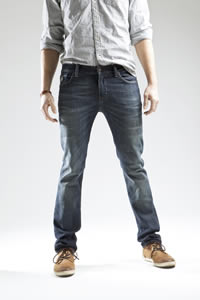Difference between Cotton Jeans and Denim Jeans
Key difference: Jeans are trousers that are made from denim or dungaree cloth material. Jeans were made popular by the blue denim trousers invented Levi Strauss in 1873. Denim is a rugged cotton twill textile, which means that it is made from cotton fiber which is weaved in a specific manner. Nowadays, mainly due to the popularity of jeans, numerous jeans are being produced via a cotton–polyester blend. Traditionally, denim is 100% cotton. However, a cotton cotton–polyester blend gives the jeans a lighter and stretcher consistency than pure denim.

Styles continue to change depending on the newest trend to hit the market or the runway. Style, trend and fashion are never constant. However, one of the most longest and constant trends have appeared to be jeans. The style of the jeans may vary, but the jeans itself is eternal.
Jeans are trousers that are made from denim or dungaree cloth material. Jeans were made popular by the blue denim trousers invented Levi Strauss in 1873. Denim is a rugged cotton twill textile, which means that it is made from cotton fiber which is weaved in a specific manner. The twill stands for the weave in which the weft passes under two or more warp threads. The weave leaves a distinct pattern of alternating and interwoven blue and white cotton threads.The twill weaving gives denim its iconic look and is what distinguished it from other cotton weaves.
Denim material was invented in Nimes, France, from where it acquires its name de Nimes (from Nimes), or in short denims. Jeans were usually dyed with the most popular dye at that time, indigo, which gave its dark blue color. Jeans become a popular material during the gold rush in mid-1800s, when the miners required sturdy cloth that would not tear or damage easily. Strauss’ denim jean overalls made the perfect material for this type of work. Strauss and Jacob Davis are often credited for inventing the modern jeans. Strauss and Jacob initially patented the metal rivets on the pockets, to keep the pockets from ripping away from the rest of the fabric.

Jeans become a fashion trend during the 1950s when cowboys were sported wearing jeans in western movies. During the same decade, movies such as Rebel Without a Cause, promoted the jeans to become a teenage rebel symbol. These jeans started gaining popularity as they were being banned from many colleges and schools. As jeans become popular, they started being made in different styles, colors, cut, etc. These days, jeans are available in various different colors (pink, blue, black, etc) and various different styles (high rise, low rise, boot cut, skinny, bell-bottoms, flare, wide, straight leg, etc).
Nowadays, mainly due to the popularity of jeans, numerous jeans are being produced via a cotton–polyester blend. Traditionally, denim is 100% cotton. However, a cotton cotton–polyester blend gives the jeans a lighter and stretcher consistency than pure denim. Furthermore, cotton jeans can be dyed in more colors than are possible with demin. Also, cotton jeans are more resistant to fading and fade marks or patterns, including whiskers - faded streaks that surround the crotch area of the denim, honey combs - streaks of faded lines found behind the knee, stacks - extra fabric stacks on top of the shoe causing a fade to form around the ankle to calf area of the denim, and train tracks – found on the outseams of the denim.
Image Courtesy: blog.gaastraproshop.com, metaefficient.com









Add new comment